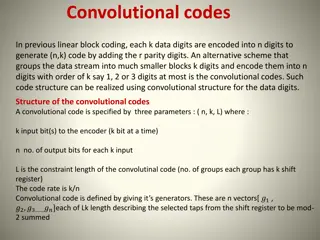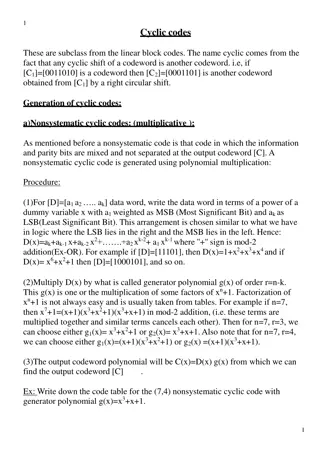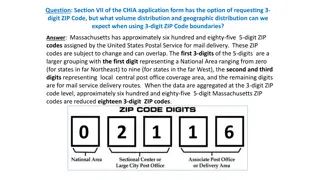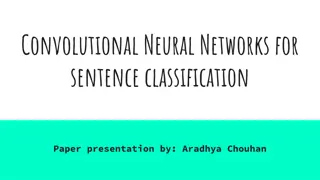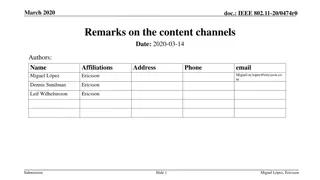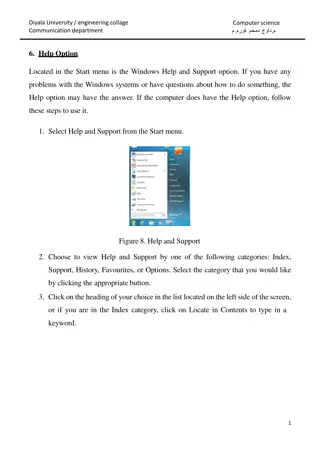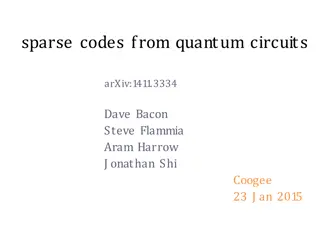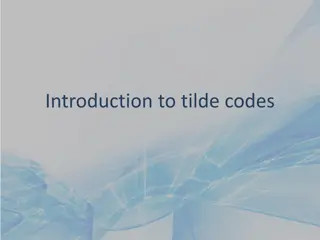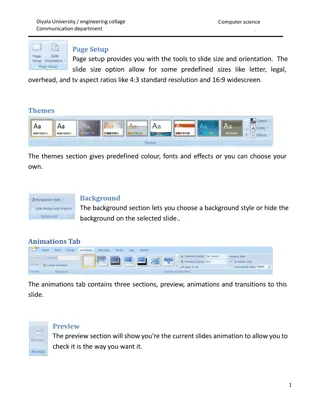Convolutional Codes in Information Theory at University of Diyala
Concepts of convolutional codes and their application in error control coding within the Information Theory program at the University of Diyala's Communication Department. Understand the unique encoding process of convolutional encoders and the significance of parameters like coding rate and constraint length. Dive into the effective code rate calculations and encoder representations for convolutional codes.
Download Presentation

Please find below an Image/Link to download the presentation.
The content on the website is provided AS IS for your information and personal use only. It may not be sold, licensed, or shared on other websites without obtaining consent from the author.If you encounter any issues during the download, it is possible that the publisher has removed the file from their server.
You are allowed to download the files provided on this website for personal or commercial use, subject to the condition that they are used lawfully. All files are the property of their respective owners.
The content on the website is provided AS IS for your information and personal use only. It may not be sold, licensed, or shared on other websites without obtaining consent from the author.
E N D
Presentation Transcript
University of Diyala Information Theory Marwa Mohammed Communication department / Engineering collage The University of Diyalia 2017-2018
Convolutional codes Convolutional codes offer an approach to error control coding substantially different from that of block codes. A convolutional encoder: encodes the entire data stream, into a single codeword. does not need to segment the data stream into blocks of fixed size. is a machine with memory. 2
Convolutional codes-contd A Convolutional code is specified by three parameters (n, k, K ) or (k / n, K ) where = k /n is the coding rate, determining the number of data bits per coded bit. In practice, usually k=1 is chosen. K is the constraint length of the encoder and the encoder has K-1 memory elements. Rc 3
A Rate Convolutional encoder Convolutional encoder (rate , K=3) 3 shift-registers where the first one takes the incoming data bit and the rest, form the memory of the encoder. u1 First coded bit (Branch word) Input data bits m Output coded bits u1,u2 u2 Second coded bit 4
A Rate Convolutional encoder m = (101) Message sequence: Time Time Output (Branch word) Output (Branch word) u1 u1 u1 u2 u1 1 0 u2 0 1 0 t1 t2 1 1 1 0 0 u2 u2 u1 u1 u1 0 0 u2 u1 1 0 u2 1 0 0 1 1 0 t3 t4 u2 u2 5
A Rate Convolutional encoder Time Time Output (Branch word) Output (Branch word) u1 u1 u1 u2 u1 0 0 u2 0 0 0 t6 t5 0 0 1 1 1 u2 u2 U = (11 10 00 10 11) m = (101) Encoder 6
Effective code rate Initialize the memory before encoding the first bit (all- zero) Clear out the memory after encoding the last bit (all- zero) Hence, a tail of zero-bits is appended to data bits. Encoder data tail codeword Effective code rate : L is the number of data bits and k=1 is assumed: L R =1 c Reff= n(L+ K 1) n 7
Encoder representation Vector representation: We define n binary vector with K elements (one vector for each modulo-2 adder). The i-th element in each vector, is 1 if the i-th stage in the shift register is connected to the corresponding modulo- 2 adder, and 0 otherwise. Example: u1 g = (111) 1 m u1 u2 g = (101) 2 u2 8
State diagram A finite-state machine only encounters a finite number of states. State of a machine: the smallest amount of information that, together with a current input to the machine, can predict the output of the machine. In a Convolutional encoder, the state is represented by the content of the memory. Hence, there are 2K 1 states. 9
State diagram contd A state diagram is a way to represent the encoder. A state diagram contains all the states and all possible transitions between them. Only two transitions initiating from a state Only two transitions ending up in a state 10
State diagram contd Current state S0 00 S1 01 Next state S S2 S0 S2 S1 S3 S1 S3 input output 0/00 Output (Branch word) 0 1 0 1 0 1 0 1 00 11 11 00 10 01 01 10 Input S0 0 1/11 0 / 11 00 1/00 S2 S1 01 10 S2 10 0/10 1/01 S3 0/01 11 S3 11 1/10 11
Trellis contd Trellis diagram is an extension of the state diagram that shows the passage of time. Example of a section of trellis for the rate code State S0 = 00 0/00 1/11 S2 =10 0/11 1/00 0/10 S1 = 01 1/01 0/01 1/10 S3 =11 ti ti+1 Time 12
Trellis contd A trellis diagram for the example code. Tail bits Input bits 1 0 1 0 0 Output bits 00 11 10 10 11 0/00 0/00 0/00 0/00 0/00 1/11 1/11 1/11 1/11 1/11 0/11 0/11 0/11 0/11 0/11 1/00 1/00 1/00 1/00 1/00 1/010/10 1/010/10 1/010/10 1/010/10 1/010/10 0/01 0/01 0/01 0/01 0/01 1/10 1/10 1/10 1/10 1/10 t5 t6 t1 t3 t 2 t 4 13
Trellis contd Tail bits Input bits 1 0 1 0 0 Output bits 00 11 10 10 11 0/00 0/00 0/00 0/00 0/00 1/11 1/11 1/11 0/11 0/11 0/11 1/00 0/10 0/10 1/010/10 1/01 0/01 0/01 1/10 t5 t6 t1 t3 t 2 t 4 14
The Viterbi Decoding Algorithm The Viterbi algorithm performs Maximum Likelihood decoding. It finds a path through trellis with the largest metric (maximum correlation or minimum distance). It processes the demodulator outputs in an iterative manner. At each step in the trellis, it compares the metric of all paths entering each state, and keeps only the path with the largest metric, called the survivor, together with its metric. It proceeds in the trellis by eliminating the least likely paths. It reduces the decoding complexity to L2K 1 ! 15
The Viterbi algorithm - contd Viterbi algorithm: Do the following set up: For a data block of L bits, form the trellis. has L+K-1 sections or levels and starts at time t1and ends up at time tL+K . Label all the branches in the trellis with their corresponding branch metric. For each state in the trellis at the time denoted by S(t ) {0,1,...,2K 1}, define a parameter (S(ti),ti) i Then, do the following: A. The trellis ti which is B. 16
The Viterbi algorithm - contd Set At time ti all the paths entering each state. Set (S(ti),ti)equal to the best partial path metric entering each state at time ti. Keep the survivor path and delete the dead paths from the trellis. If i L+ K, increase i by 1 and return to step 2. C. Start at state zero at time tL+K . Follow the surviving branches backwards through the trellis. The path thus defined is unique and correspond to the ML codeword. 1. 2. (0,t1) = 0 and , compute the partial path metrics for i = 2. 3. 4. 17
Example of Viterbi decoding m = (101) Source message U = (11 10 00 10 11) Codeword to be transmitted Z = (11 10 11 10 01) Received codeword 0/00 0/00 0/00 0/00 0/00 1/11 1/11 1/11 0/11 0/11 0/11 1/00 0/10 0/10 0/10 1/01 1/01 0/01 0/01 1/10 t 5 t6 t1 t 3 t2 t4 18
Example of Viterbi decoding-contd Label all the branches with the branch metric (Hamming distance) (S(ti),ti) 0 2 1 2 1 1 1 0 0 0 1 1 2 0 0 1 1 2 2 1 1 t t t1 t t t 5 6 3 2 4 19
Example of Viterbi decoding-contd i=2 0 2 2 1 2 1 1 1 0 0 0 0 1 1 2 0 1 0 1 2 2 1 1 t t t1 t t t 5 6 3 2 4 20
Example of Viterbi decoding-contd i=3 0 2 3 2 1 2 1 1 1 0 0 0 3 0 1 1 2 0 1 0 0 1 2 2 1 2 1 t t t1 t t t 5 6 3 2 4 21
Example of Viterbi decoding-contd i=4 0 2 3 0 2 1 2 1 1 1 0 0 0 3 2 0 1 1 1 2 0 0 0 3 1 2 2 1 2 3 1 t t t1 t t t 5 6 3 2 4 22
Example of Viterbi decoding-contd i=5 0 2 3 0 1 2 1 2 1 1 1 0 0 0 3 2 0 1 1 1 2 0 0 0 3 2 1 2 2 1 2 3 1 t t t1 t t t 5 6 3 2 4 23
Example of Viterbi decoding-contd i=6 0 2 3 0 1 2 2 1 2 1 1 1 0 0 0 3 2 0 1 1 1 2 0 0 0 3 2 1 2 2 1 2 3 1 t t t1 t t t 5 6 3 2 4 24
Example of Viterbi decoding-contd Trace back and then: m = (100) U = (11 10 11 00 00) There are some decoding errors. 0 2 3 0 1 2 2 1 2 1 1 1 0 0 0 3 2 0 1 1 1 2 0 0 0 3 2 1 2 2 1 2 3 1 t t t1 t t t 5 6 3 2 4 25




